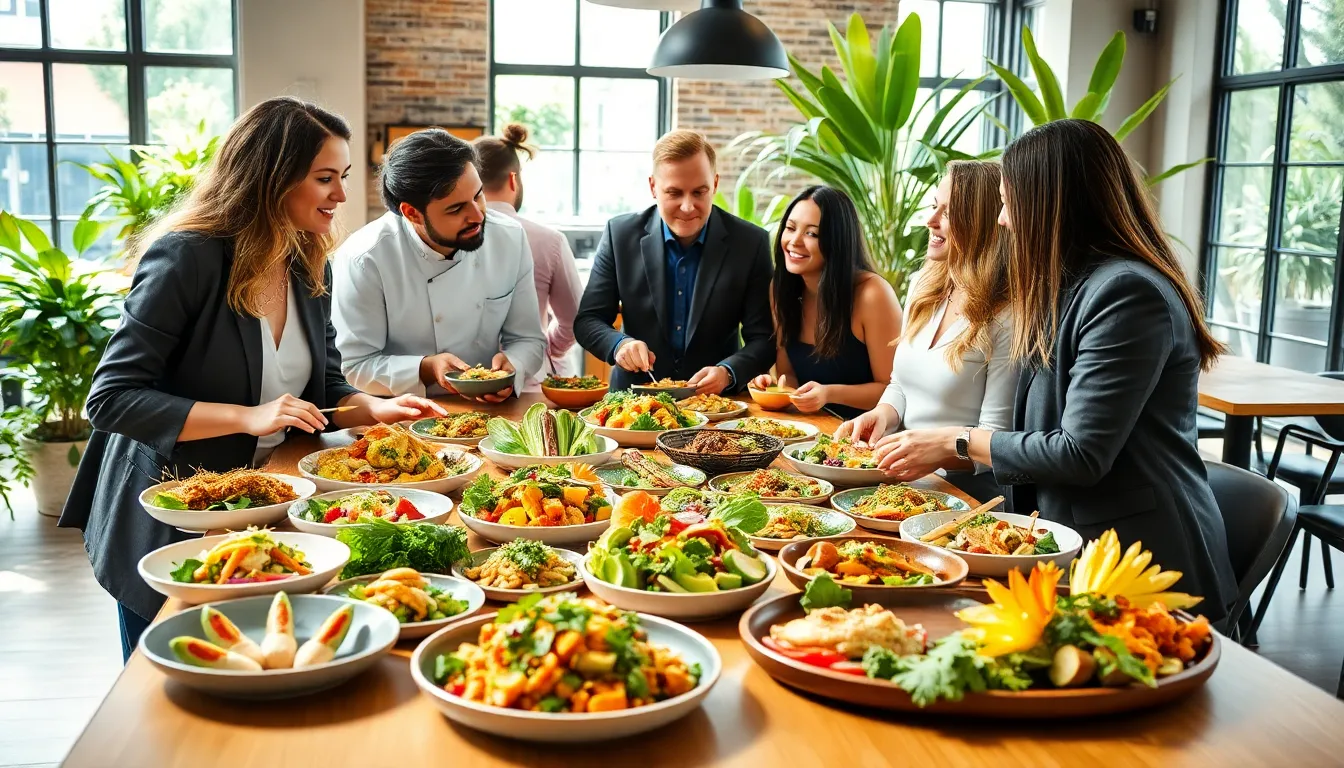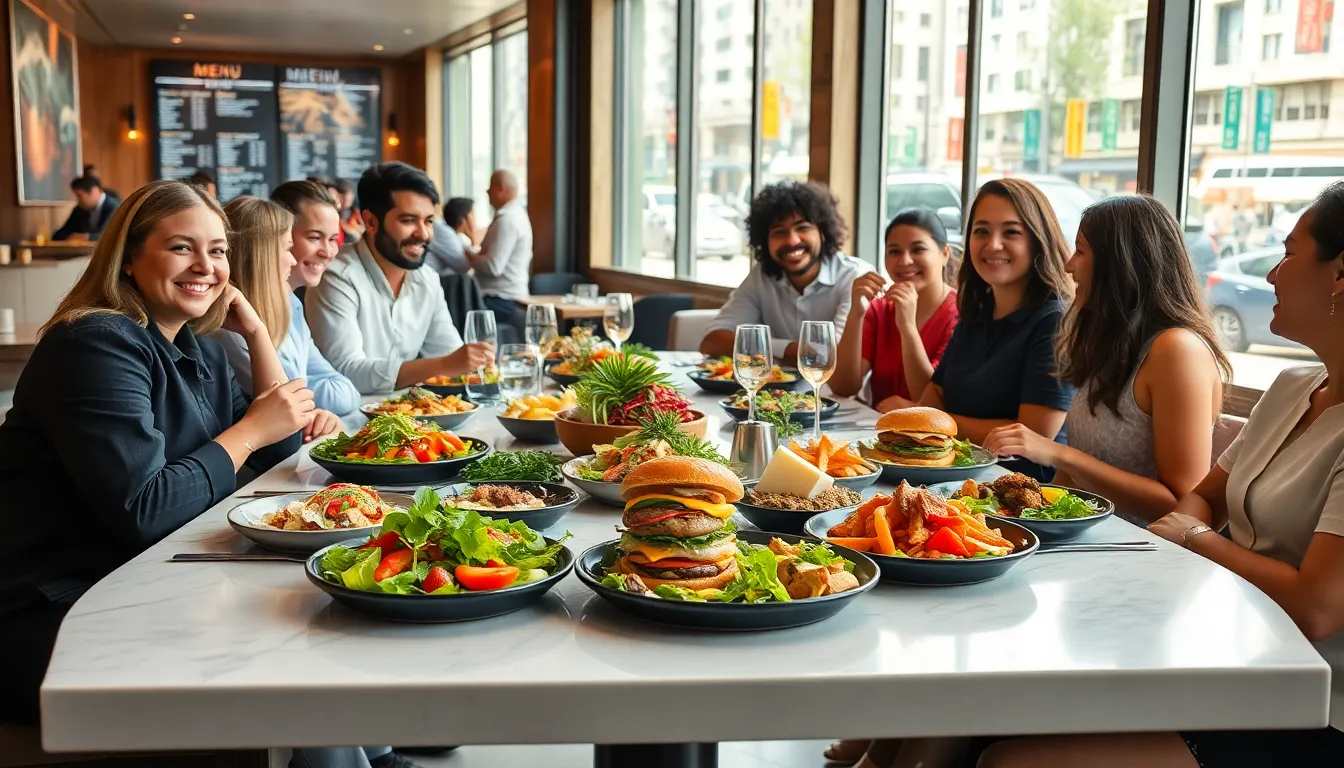Table of Contents
ToggleWith the culinary landscape evolving at breakneck speed, the latest food trends are not just about what’s on the plate, they’re a reflection of our values, lifestyles, and even our sense of humor. It’s time to dig into what’s sizzling in the kitchen. From plant-based diets that promise to make cows breathe a collective sigh of relief, to social media challenges that might make you question your dinner choices, the modern dining experience is anything but boring. Let’s explore the trends that are heating up our menus and changing the way we think about food.
The Rise of Plant-Based Diets

Plant-based diets have exploded in popularity, and for good reason. They’re not just a fad but a pivotal lifestyle shift. Many people are trading beef for beans and opting for almond milk over cow’s milk as they become increasingly aware of the environmental impact of their food choices. This transition is also fueled by health concerns, as studies continue to reveal the benefits of a diet rich in fruits, vegetables, and grains.
Recent estimates suggest that about 6% of Americans now follow a plant-based diet, and this number is steadily rising. Not only are restaurants increasingly adding plant-based options, but the market for meat substitutes is booming, with innovations like lab-grown meat and legume-based burgers taking center stage. People are discovering that they can enjoy a delicious and satisfying meal without animal products, leading to a vibrant culinary scene packed with creativity.
Also, the rise of plant-based eating encourages exploration. Chefs are getting inventive, whipping up dishes that could convince even the staunchest carnivore to reconsider their ways.
By making conscious choices, individuals are not just participating in a diet: they’re embracing a lifestyle that promotes sustainability and compassion towards animals. This trend may very well continue to reshape the future of food.
Sustainable and Locally Sourced Ingredients
Sustainability is no longer a buzzword, it’s a way of life. With the rise of food awareness, diners are keen to know where their ingredients come from. Local farms and sustainable agricultural practices have become essential staples on menus across the nation.
The demand for locally sourced ingredients not only supports farmers but also reduces the carbon footprint associated with food transportation. In fact, gastronomes are increasingly prioritizing dishes made with seasonal, local produce. When restaurants proudly display “farm-to-table” labels, they’re not just flaunting their eco-friendliness: they’re also engaging in a meaningful dialogue about food quality and freshness.
As a result, chefs are creating menus that change with the seasons, offering dishes that highlight the best each time of year has to offer. This commitment to locality brings with it an added layer of flavor and freshness while fostering a sense of community between consumers and producers. Customers today want to know their farmers just as well as they know their chefs.
Health-Conscious Eating Habits
Health has become a driving force behind food preferences. As consumers become more aware of nutritional information, they’re demanding healthier options. Foods rich in antioxidants, fiber, and essential nutrients are now prized possessions on menus, while processed foods are starting to lose their charm at an alarming rate.
Meal prepping is the new cool kid on the block, and it’s not just for gym enthusiasts anymore. Busy lifestyles and wellness insights are prompting many to plan their meals, packing nutritious lunches instead of opting for fast food. Ingredients like quinoa, kale, and acai berries are must-haves in pantry staples.
Also, dietary restrictions and preferences have been front and center, with gluten-free, nut-free, and dairy-free options becoming essential offerings in restaurants. This openness toward accommodating different diets showcases a growing commitment to inclusivity. It’s as if the culinary world is embracing everyone, ensuring no one is left out of the food fun.
Global Cuisine and Fusion Foods
The world is more connected than ever, and our plates reflect this globalization. Diners are craving something different, something exotic. That means fusion cuisine is taking off. It’s not unusual to find a taco joint serving Korean BBQ, or a sushi bar with a twist that includes spicy tuna on a pizza.
This mash-up of flavors is exciting for many reasons. For one, it introduces people to the delightful intricacies of various cultures without needing a passport. From bold spices to unpronounceable ingredients, global cuisine is challenging palates and expanding culinary horizons. Restaurants are becoming melting pots, literally, by blending culinary traditions and giving birth to exciting new dishes.
The fun doesn’t stop at flavor combinations: it’s also about accessibility. Food trucks are popping up everywhere, serving the types of dishes previously found only in gourmet restaurants, making unique eats more available and affordable. As a result, food culture is thriving in a melting pot of tastes.
Technological Innovations in Food Preparation
The culinary world isn’t just about ingredients: technology is reshaping how food is prepared. Innovative kitchen gadgets are making waves, stealing the spotlight from traditional cooking methods. Brands have stepped up with tools like air fryers and sous-vide machines, allowing home cooks to replicate restaurant-quality meals.
Apps are changing the game as well. Meal planning, grocery shopping, and even cooking with step-by-step guides are all just a tap away on smartphones. Cooking shows are broadcast live, letting everyone peek into professional kitchens and learn chef secrets in real time.
This tech-savvy approach is attracting a younger demographic that craves convenience alongside creativity. Cooking is becoming less of a chore and more of an engaging activity for families, turning mealtime into an event rather than a necessity.
Food Waste Reduction Efforts
As awareness grows around food waste, individuals and businesses alike are stepping up to make a change. The statistics are startling: nearly one-third of all food produced globally is wasted. This shocking reality is driving initiatives aimed at reducing waste, promoting efficiency, and turning surplus into meals.
Restaurants are adopting practices such as composting, donating unserved food, and even repurposing leftovers into new menu items. It’s inspiring to see culinary creativity solving the problem of food waste. From chefs crafting gourmet dishes from yesterday’s bread to organizations connecting excess food with those in need, this effort highlights the importance of resourcefulness in a world that too often takes abundance for granted.
Consumers are also becoming more mindful about their purchases. Many are learning to shop smarter, avoid overbuying, and find ways to keep food fresh for longer, all while maintaining their budgets. This collective mindset shift is crucial in making reduction efforts effective.
The Role of Social Media in Shaping Trends
Social media plays a formidable role in shaping food trends today, making it an essential player in how we discover and engage with food culture. Platforms like Instagram and TikTok are overflowing with meticulously styled food photos and quick recipe videos, sparking culinary creativity all over the world. What’s the buzz? Hashtags dominate, leading foodies and home cooks alike on taste adventures, often trending based on what perfectly captured plate is served that day.
Sharing experiences is a crucial aspect of dining. Whether it’s a restaurant’s signature dish or a home-cooked masterpiece, social media provides a platform for all food enthusiasts to engage with one another, share tips, and inspire. This constant exchange creates an ongoing dialogue about what’s delicious and what’s not.
Also, influencers curate health-conscious options and highlight sustainability, encouraging followers to explore new flavors while being mindful of their choices. As a result, the virality of certain dishes can have a significant impact, before one knows it, a trend can go from obscure to undeniable practically overnight.







